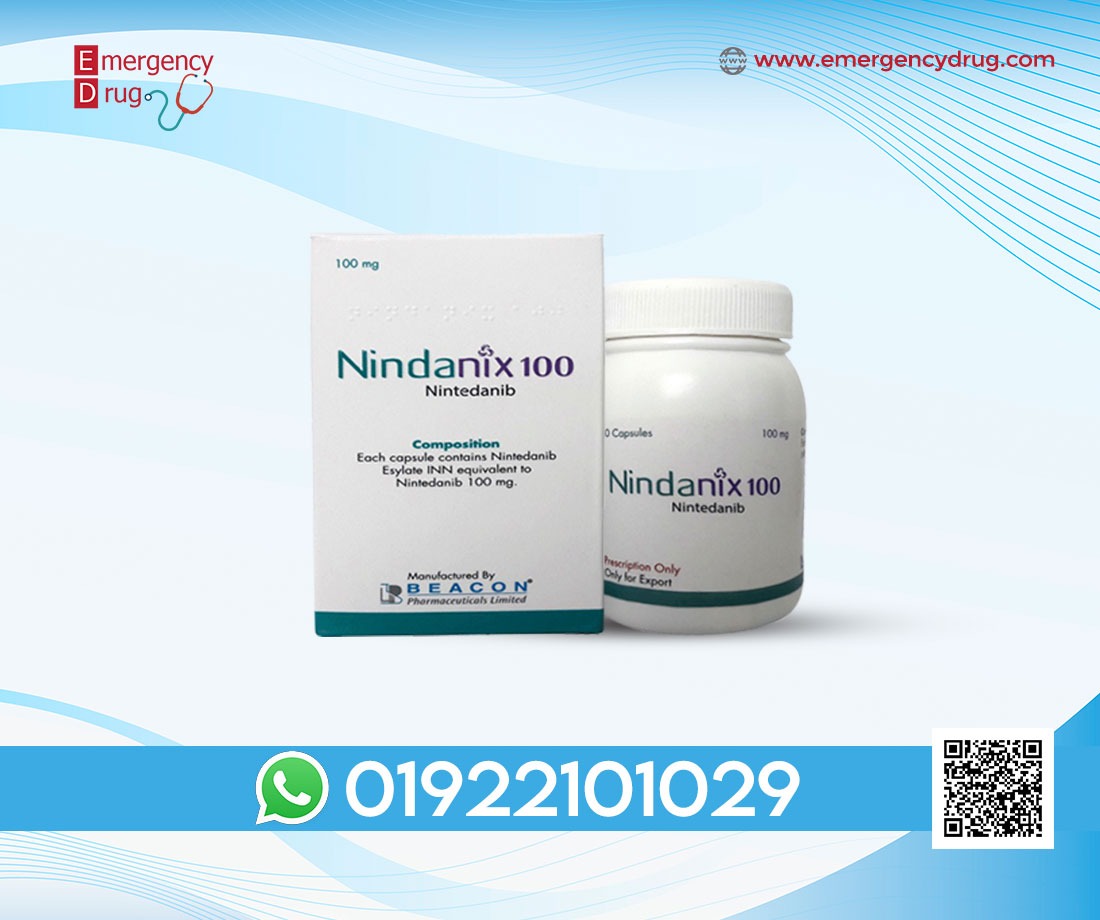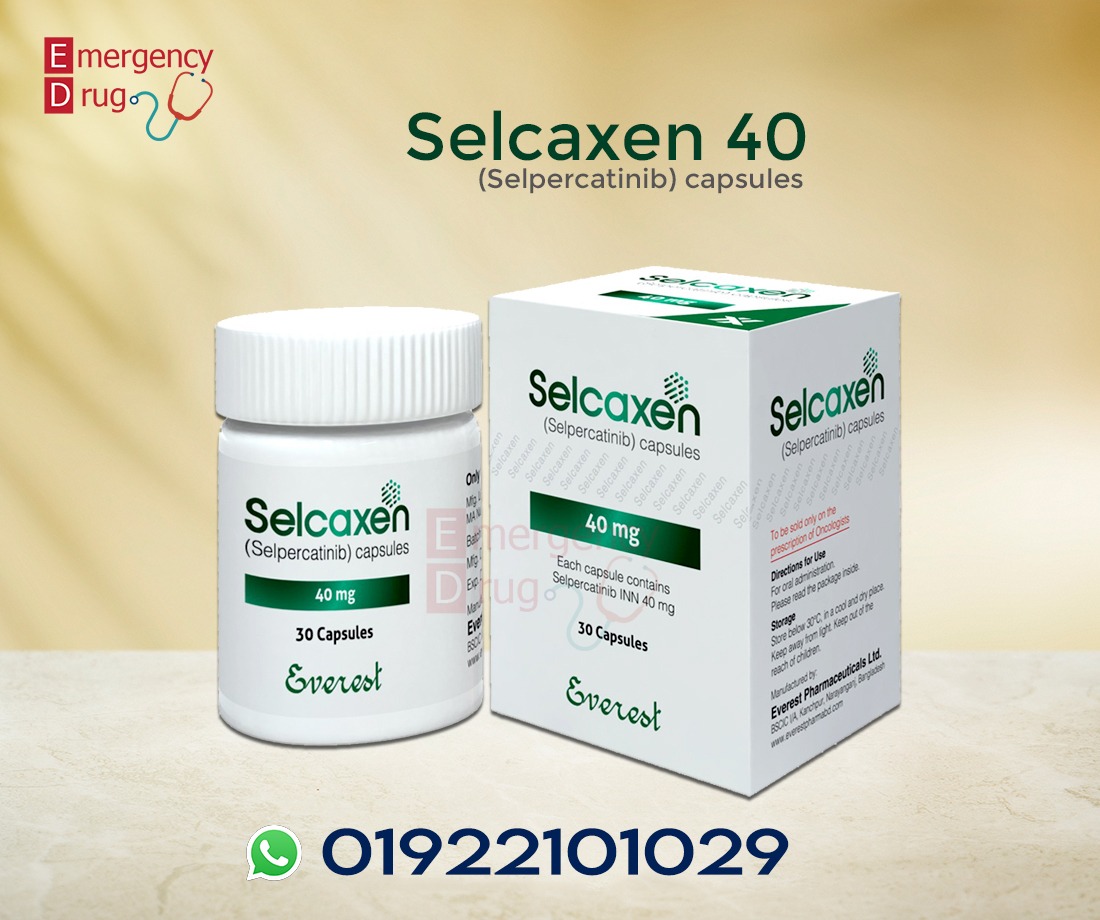
Niranib (Niraparib) 100 Mg – 30 Capsules
Price: $215.00
Niranib is an anti-cancer chemotherapy medicine which known as a PARP or poly ADP ribose polymerase inhibitor which use for the treatment of cancer. Niranib works as targeted therapy where it is highly selective for PARP1 and PARP2 which work to detect DNA damage and promote repair. Niranib inhibits the activity of PARP1 and PARP2 which results in cancerous cell death.


Description
Niranib (Nirapanib) 100 Mg Capsules manufacture Everest Pharma consists of Niraparib molecule which use for the treatment of recurrent epithelial ovarian, fallopian tube, or primary peritoneal cancer. Consult your doctor before consuming this. This molecule is marketed by Everest with the brand name Niranib 100 mg. Consumer needs to provide a prescription copy to buy anti-cancer & other medicines from Glareamed. We deal in all generics for Molecule – Niraparib.
| US Brand Name | Niranib |
| Generic Name | Niraparib |
| Other Brand Name | Niranib |
| Packing | 30 |
| Manufacturer | Everest Pharma |
| Form | Capsule |
| Strength | 100mg |
| Country | Bangladesh |
Pharmacology
Niraparib is an inhibitor of poly (ADP-ribose) polymerase (PARP) enzymes, PARP-1 and PARP-2, which play a role in DNA repair. In vitro studies have shown that niraparib induced cytotoxicity may involve inhibition of PARP enzymatic activity and increased formation of PARP-DNA complexes resulting in DNA damage, apoptosis and cell death. Increased Niraparib-induced cytotoxicity was observed in tumor cell lines with or without deficiencies in BRCA1/2. Niraparib decreased tumor growth in mouse xenograft models of human cancer cell lines with deficiencies in BRCA1/2 and in human patient-derived xenograft tumor models with homologous recombination deficiency that had either mutated or wild type BRCA1/2.
Absorption
The absolute bioavailability of niraparib is approximately 73%. Following oral administration of Niraparib, peak plasma concentration, Cmax, is reached within 3 hours. Concomitant administration of a high fat meal (800-1,000 calories with approximately 50% of total caloric content of the meal from fat) did not significantly affect the pharmacokinetics of Niraparib.
Distribution
Niranib is 83.0% bound to human plasma proteins. The average (±SD) apparent volume of distribution (Vd/F) was 1220 (±1114) L. In a population pharmacokinetic analysis, the Vd/F of Niraparib was 1074 L in cancer patients.
Elimination
Following multiple daily doses of 300 mg Niraparib, the mean half-life (t1/2) is 36 hours. In a population pharmacokinetic analysis, the apparent total clearance (CL/F) of niraparib was 16.2 L/h in cancer patients.
Metabolism
Niraparib is metabolized primarily by carboxylesterases (CEs) to form a major inactive metabolite, which subsequently undergoes glucuronidation.
Excretion
Following administration of a single oral 300 mg dose of radio-labeled Niraparib, the average percent recovery of the administered dose over 21 days was 47.5% (range 33.4% to 60.2%) in urine and 38.8% (range 28.3% to 47.0%) in feces. In pooled samples collected over 6 days, unchanged Niraparib accounted for 11% and 19% of the administered dose recovered in urine and feces, respectively
Dosage & Administration
Interaction
Inhibition of CYPs (CYP1A2, CYP2B6, CYP2C8, CYP2C9, CYP2C19, CYP2D6, and CYP3A4). Neither Niraparib nor M1 is an inhibitor of any active ubstance-metabolising CYP enzymes, namely CYP1A1/2, CYP2B6, CYP2C8, CYP2C9, CYP2C19, CYP2D6 and CYP3A4/5. Even though inhibition of CYP3A4 in the liver is not expected, the potential to inhibit CYP3A4 at the intestinal level has not established at relevant Niraparib concentrations. Therefore, caution recommend when Niraparib combine with active substances the metabolism of which is CYP3A4-dependent and, notably, those having a narrow therapeutic range (e.g. ciclosporin, tacrolimus, alfentanil, ergotamine, pimozide, quetiapine and halofantrine).
Induction of CYPs (CYP1A2 and CYP3A4): Neither Niraparib nor M1 is a CYP3A4 inducer in vitro. In vitro, Niraparib weakly induces CYP1A2 at high concentrations and the clinical relevance of this effect would not completely ruled out. M1 is not a CYP1A2 inducer. Therefore, caution recommend when niraparib is combined with active substances the metabolism of which is CYP1A2-dependent and, notably, those having a narrow therapeutic range (e.g. clozapine, theophylline and ropinirole).
Contraindications
Side Effects
Pregnancy & Lactation
Women of childbearing potential/contraception in females Women of childbearing potential should not become pregnant while on treatment and should not pregnant at the beginning of treatment. A pregnancy test should perform on all women of childbearing potential prior to treatment. Women of childbearing potential must use effective contraception during therapy and for 1 month after receiving the last dose of Niraparib.
Pregnancy: There are no or limited amount of data from the use of Niraparib in pregnant women. Animal reproductive and developmental toxicity studies have not conducted. However, base on its mechanism of action, niraparib cause embryonic or foetal harm, including embryo-lethal and teratogenic effects, when administer to a pregnant woman. Niraparib should not use during pregnancy.
Breast-feeding: It is unknown whether Niranib or its metabolites excrete in human milk. Breast-feeding is contraindicated during administration of Niraparib and for 1 month after receiving the last dose.
Fertility: There are no clinical data on fertility. A reversible reduction of spermatogenesis was observed in rats and dogs.
Precautions & Warnings
Myelodysplastic syndrome/acute myeloid leukemia
Myelodysplastic syndrome/acute myeloid leukemia (MDS/AML), including cases with fatal outcome, have reported in a small number of patients who receive Niraparib or placebo. In the pivotal Phase 3 international trial (ENGOT-OV16), the incidence of MDS/AML in patients who receive niraparib (1.4%) was similar to that in patients who receive placebo (1.1%). Overall, MDS/AML has reported in 7 out of 751 (0.9%) patients treat with Niraparib in clinical studies.
The duration of Niraparib treatment in patients prior to developing MDS/AML varied from 1 month to > 2 years. The cases were typical of secondary, cancer therapy-related MDS/AML. All patients receive multiple platinum-containing chemotherapy regimens and many also receive other DNA damaging agents and radiotherapy. Some of the patients had a history of bone marrow dysplasia. If MDS and/or AML confirm while on treatment with Niraparib, treatment should discontinue and the patient treated appropriately.
Hypertension including hypertensive crisis
Hypertension, including hypertensive crisis, has reported with the use of Niraparib. Pre-existing hypertension should adequately control before starting Niraparib treatment. Blood pressure should monitor monthly for the first year and periodically thereafter during treatment with Niraparib. Hypertension should medically manage with antihypertensive medicinal products as well as adjustment of the Niraparib dose, if necessary. In the clinical program, blood pressure measurements obtain on Day 1 of each 28-day cycle while the patient remained on Niraparib. In most cases, hypertension control adequately using standard antihypertensive treatment with or without Niraparib dose adjustment. Niraparib should discontinue in case of hypertensive crisis or if medically significant hypertension cannot adequately controlled with antihypertensive therapy.
Pregnancy/contraception
Niranib should not use during pregnancy or in women of childbearing potential not willing to use reliable contraception during therapy and for 1 month after receiving the last dose of Niraparib. A pregnancy test should perform on all women of childbearing potential prior to treatment.
Lactose
Niraparib hard capsules contain lactose monohydrate. Patients with rare hereditary problems of galactose intolerance, the Lapp lactase deficiency or glucose galactose malabsorption should not take this medicine.
Tartrazine (E102): This medicinal product contains tartrazine (E 102), which may cause allergic reactions.
Use in Special Populations
Elderly: No dose adjustment is necessary for elderly patients (> 65 years). There are limited clinical data in patients aged 75 or over.
Pediatric population: The safety and efficacy of niraparib in children and adolescents below 18 years of age have not yet established.
Renal impairment: No dose adjustment is necessary for patients with mild to moderate renal impairment. There are no data in patients with severe renal impairment or end-stage renal disease undergoing hemodialysis; use with caution in these patients.
Hepatic impairment: No dose adjustment need in patients with mild to moderate hepatic impairment. There are no data in patients with severe hepatic impairment; use with caution in these patients.
Overdose Effects
Therapeutic Class
Storage Conditions
Store in a cool and dry place. Do not store above 30°C. Do not take Niranib if it suspect of having expose to temperatures greater than 40°C or 104°F. Keep Niraparib out of the reach and sight of children.















Reviews
There are no reviews yet.